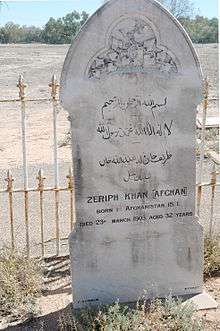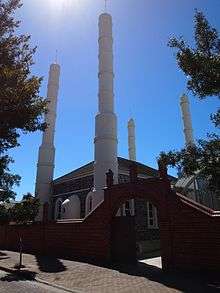Afghan (Australia)
|
Part of a series on |
| History |
|
Early history |
| Mosques |
|
List of mosques |
| Organisations |
|
Islamic organisations in Australia |
| Groups |
|
Afghan • Albanian • Arab • Bangladeshi |
| Events |
| People |
| Prominent Australian Muslims Ibrahim Abu Mohamed |


in Little Gilbert Street, Adelaide
The "Afghans" or "Ghans" were camel caravaners who worked in Outback Australia from the 1860s to the 1930s. They included Pashtun, Punjabi, Baloch and Sindhi men from the region between the southern Hindu Kush in Afghanistan and the Indus River in what is now Pakistan,[1] as well as others from Kashmir, Rajasthan, Egypt, Persia and Turkey.[2] Besides providing vital support to exploration and settlement of the arid interior of the country, these cameleers played a major role in establishing Islam in Australia, building the country's first mosque at Marree in South Australia.
History
The first Afghan cameleers arrived in Melbourne in June 1860, when three men arrived with a shipment of 24 camels for the Burke and Wills expedition.[2] Afghans without camels are reported to have reached Australia as early as 1838.[3] Before the building of railways and the widespread adoption of motor vehicles, camels were the primary means of bulk transport in the Outback, where the climate was too harsh for horses and other beasts of burden. After their use was superseded by modern transport, some cameleers released their camels into the wild, and a large population of feral camels remains from this time. From 1850-1900, Afghani camel handlers played an important part in opening up Central Australia, helping in building of telegraph and railway lines. They also helped the growth of Muslims in Australia before 1850.
Impact
Even though the Afghans' help was greatly appreciated they were also subject to discrimination because of their religion and appearance, and because of the competition they provided to European bullock teamsters.[2] Many of those European competitors were also cameleers and in 1903 a European camel train proprietor of Wilcannia replaced all of his Afghan camel drivers with Europeans.[4]
The passenger train which travels between Adelaide and Darwin is known as "The Ghan" (formerly The Afghan Express) as a tribute to the service the Afghans provided to the areas through which the train travels.[5] The total number of Afghans to settle in Australia was approximately 3,000, with over 2,000 arriving between 1870 and 1900.[2]
Establishment of mosques
At Marree, an important junction of the camel trade, the Afghan cameleers built the earliest mosque in Australia in 1861,[2] but this subsequently fell into disuse and was demolished. Over time as some members of the Afghan community prospered through trade and camel breeding, they contributed towards the building of the oldest permanent mosque in Australia, in Adelaide in 1888–89,[6] as well as the Perth mosque, which dates from 1905.[7]
Notable people
See also
References
- ↑ Westrip, J. & Holroyde, P. (2010): Colonial Cousins: a surprising history of connections between India and Australia. Wakefield Press. ISBN 1862548412, p. 175.
- 1 2 3 4 5 australia.gov.au > About Australia > Australian Stories > Afghan cameleers in Australia Accessed 8 May 2014.
- ↑ Flinders Range Research - The Afghan Camelmen
- ↑ National Advocate newspaper, 17 April 1903, page 2.
- ↑ Afghan Express
- ↑ Weekend Notes > Adelaide City Afghan Mosque Accessed 8 May 2014.
- ↑ Westrip & Holroyde & p. 193.
- Stevens, Christine (2003) [1989]. Tin Mosques and Ghan Towns: A History of Afghan Camel Drivers in Australia. ISBN 0-9581760-0-0.
External links
- Bibliography on Camels and Cameleers at the Northern Territory Library.
- Flinders Ranges Research > The Afghan Camelmen Accessed 8 May 2014.
- ABC TV > George Negus Tonight > Afghan Cameleers Broadcast transcript, 1 November 2004. Accessed 8 May 2014.
- Pioneering Afghans from Bushmag.
